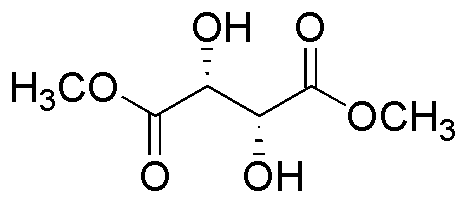(+)-Dimethyl L-tartrate is widely utilized in research focused on:
- Pharmaceutical Development: This compound serves as a chiral building block in the synthesis of various pharmaceuticals, enhancing the efficacy and safety profiles of drugs.
- Flavoring and Fragrance Industry: Its pleasant taste and aroma make it a valuable ingredient in food and cosmetic formulations, providing a natural flavoring agent.
- Biochemical Research: Used in studies involving enzymatic reactions, it helps researchers understand metabolic pathways and enzyme functions more effectively.
- Chiral Separation Techniques: It plays a crucial role in the development of chiral chromatography methods, allowing for the efficient separation of enantiomers in complex mixtures.
- Green Chemistry Applications: As a biodegradable compound, it supports sustainable practices in chemical manufacturing, reducing environmental impact compared to traditional solvents.
General Information
Properties
Safety and Regulations
Applications
(+)-Dimethyl L-tartrate is widely utilized in research focused on:
- Pharmaceutical Development: This compound serves as a chiral building block in the synthesis of various pharmaceuticals, enhancing the efficacy and safety profiles of drugs.
- Flavoring and Fragrance Industry: Its pleasant taste and aroma make it a valuable ingredient in food and cosmetic formulations, providing a natural flavoring agent.
- Biochemical Research: Used in studies involving enzymatic reactions, it helps researchers understand metabolic pathways and enzyme functions more effectively.
- Chiral Separation Techniques: It plays a crucial role in the development of chiral chromatography methods, allowing for the efficient separation of enantiomers in complex mixtures.
- Green Chemistry Applications: As a biodegradable compound, it supports sustainable practices in chemical manufacturing, reducing environmental impact compared to traditional solvents.
Documents
Safety Data Sheets (SDS)
The SDS provides comprehensive safety information on handling, storage, and disposal of the product.
Product Specification (PS)
The PS provides a comprehensive breakdown of the product’s properties, including chemical composition, physical state, purity, and storage requirements. It also details acceptable quality ranges and the product's intended applications.
Certificates of Analysis (COA)
Search for Certificates of Analysis (COA) by entering the products Lot Number. Lot and Batch Numbers can be found on a product’s label following the words ‘Lot’ or ‘Batch’.
Numéro de catalogue
Numéro de lot/série
Certificates Of Origin (COO)
This COO confirms the country where the product was manufactured, and also details the materials and components used in it and whether it is derived from natural, synthetic, or other specific sources. This certificate may be required for customs, trade, and regulatory compliance.
Numéro de catalogue
Numéro de lot/série
Safety Data Sheets (SDS)
The SDS provides comprehensive safety information on handling, storage, and disposal of the product.
DownloadProduct Specification (PS)
The PS provides a comprehensive breakdown of the product’s properties, including chemical composition, physical state, purity, and storage requirements. It also details acceptable quality ranges and the product's intended applications.
DownloadCertificates of Analysis (COA)
Search for Certificates of Analysis (COA) by entering the products Lot Number. Lot and Batch Numbers can be found on a product’s label following the words ‘Lot’ or ‘Batch’.
Numéro de catalogue
Numéro de lot/série
Certificates Of Origin (COO)
This COO confirms the country where the product was manufactured, and also details the materials and components used in it and whether it is derived from natural, synthetic, or other specific sources. This certificate may be required for customs, trade, and regulatory compliance.

